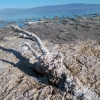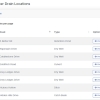
Culverts are among the most overlooked pieces of municipal infrastructure, yet they play a critical role in keeping roads passable and communities safe from flooding. When a culvert fails, the results can be immediate and costly: road washouts, property damage, and emergency closures. That is why regular, well-documented inspections are so important. Whether you are a town highway department or a stormwater manager, knowing what to look for, and how to record it, can make the difference between routine maintenance and an expensive failure. Here are five common red flags to watch for during culvert inspections, along with practical tools to help you catch them early.
1. Joint Separation or Misalignment
When pipe sections start to pull apart or settle unevenly, it is a sign that the soil around the culvert is shifting or that installation was imperfect. These gaps allow soil infiltration, which can lead to voids and eventual road collapse. Measuring tapes and inspection cameras are helpful here, but a digital record - complete with photos and GPS coordinates - lets you track movement over time and verify whether the problem is stable or worsening.
2. Corrosion and Material Deterioration
Metal culverts are especially prone to corrosion at the invert (the bottom section where water flows). Rust and pitting may not seem urgent at first, but once perforations form, you are on borrowed time. Even concrete and plastic culverts can degrade from chemical runoff or UV exposure. Documenting each inspection with a structured checklist ensures corrosion is noted before it becomes critical. Asset management software can also alert you when a structure reaches its expected service life.
3. Blockages and Sediment Buildup
A culvert can look fine structurally but fail hydraulically if it is choked with debris or sediment. Leaves, branches, and gravel buildup reduce flow capacity and can lead to upstream flooding. This is one of the simplest problems to detect visually, but without consistent inspection intervals and records, the issue can go unnoticed until after a storm. Using inspection scheduling tools and photo documentation allows departments to track recurring problem sites and justify cleaning frequency in their maintenance budgets.
4. Sinkholes or Road Surface Settlement Above the Culvert
Soft spots or dips in the pavement over a culvert often signal trouble below. Soil migration through joints or cracks causes voids that compromise the road structure. These defects may not appear directly above the pipe, making ground-penetrating radar (GPR) or even simple elevation tracking a valuable addition to visual inspections. A digital map that correlates inspection data with road locations can quickly reveal patterns and high-risk areas.
5. Undermined Inlets or Outlets
Water scouring at the inlet or outlet ends of a culvert can wash away supporting soil, leading to collapse or severe erosion. Look for exposed pipe, undercut banks, or displaced headwalls. A drone or smartphone camera can make it easier to safely capture these views without entering unstable terrain. Consistent use of inspection templates with fields for inlet/outlet conditions ensures this red flag is never missed.
Bringing It All Together with Better Tools
Even the best-trained eye needs a system to make inspection data useful. Modern stormwater and asset management tools now allow towns to log inspections directly from the field, attach photos, tag GPS coordinates, and generate reports automatically. Instead of flipping through handwritten notes or spreadsheets, a superintendent can open a dashboard and instantly see which culverts are due for cleaning, which have recurring corrosion, and which have not been inspected in more than a year.
Whether your town uses a commercial platform or an in-house database, the goal is the same: defensible, organized records that let you act before a small red flag turns into a washed-out road.
 Wetlands are often described as the kidneys of the watershed because they filter, slow, and transform the water that passes through them in ways that …
Wetlands are often described as the kidneys of the watershed because they filter, slow, and transform the water that passes through them in ways that …
 Field inspections of catch basins, manholes, culverts, and outfalls form the foundation of responsible stormwater management. These routine checks giv…
Field inspections of catch basins, manholes, culverts, and outfalls form the foundation of responsible stormwater management. These routine checks giv…
 Habitat disruption around drainage structures is often subtle at first, and many of the earliest signs tend to appear during ordinary field work rathe…
Habitat disruption around drainage structures is often subtle at first, and many of the earliest signs tend to appear during ordinary field work rathe…
 Harmful algal blooms have become one of the most pressing water quality problems in many regions, and their rise has been linked to a complicated blen…
Harmful algal blooms have become one of the most pressing water quality problems in many regions, and their rise has been linked to a complicated blen…
 The Salton Sea is one of California’s most unusual and tragic landscapes, a place shaped by accident, transformed by ambition, and ultimately pu…
The Salton Sea is one of California’s most unusual and tragic landscapes, a place shaped by accident, transformed by ambition, and ultimately pu…
 *The screenshots used in this article are from Roadwurx, an asset management software created for road maintenance departments. Managing a town’…
*The screenshots used in this article are from Roadwurx, an asset management software created for road maintenance departments. Managing a town’…